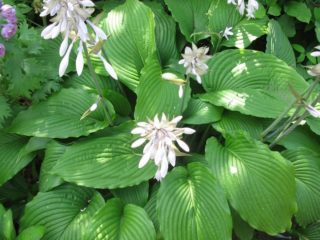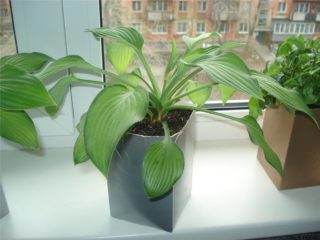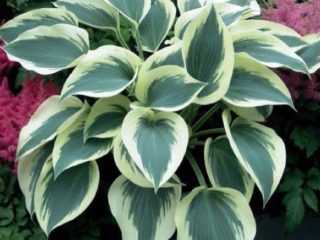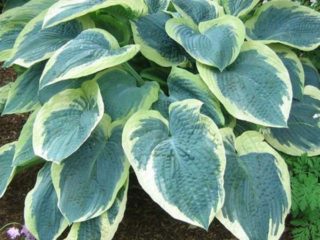Content
Khosta Blue Ivory is distinguished by very attractive, large leaves of a harmonious color: a green-blue central part with a cream-colored border. The bush grows small, but spreads in width up to 1 m or more. It completely covers the soil, which allows it to be used in carpet plantings. Blue Ivory has high winter hardiness, so it can be bred in Central Russia, Siberia and other regions.
Description of Blue Ivory hosts
Khosta Blue Ivory has dense blue leaves with a wide strip along the edge of a white or creamy shade. The leaves change their color during the season: first, the center is bluish-green, and the border is creamy, then the leaf becomes more blue, and the edge is white. Leaf size: 25 cm in length and up to 15 cm in width.
The bush grows small, no more than 45 cm, but very spreading - up to 120 cm in diameter. Blue Ivory blooms in the middle of summer, lavender buds. Refers to shade-tolerant varieties, prefers medium shade. If planted in an open area, burns form on the leaves.
In terms of frost resistance, it belongs to zone 3: it can withstand winter frosts down to -35 degrees. Therefore, it can be grown in different regions of Russia - everywhere in Central, in the Urals, as well as in Southern Siberia and the Far East.
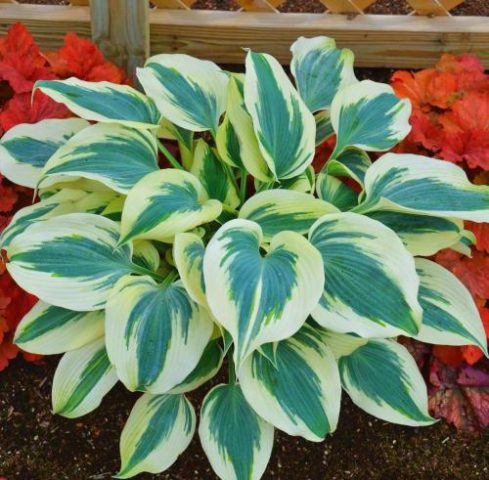
The central part of the leaf of the Blue Ivory hosta resembles the feathers or wings of a bird.
Differences between hosts Blue Ivory and Fern Line
Due to the similarity in appearance, the host is very often confused with Blue Ivory and Fern Line. They are indeed similar, but a closer look reveals the differences:
- The Fern Line hosts have a dark green leaf center, without blue tints.
- Border on the edges is light yellow.
- In addition, it is wider than Blue Ivory.

Hosta Fern Line has a pronounced greenish tone in the center, rather than blue
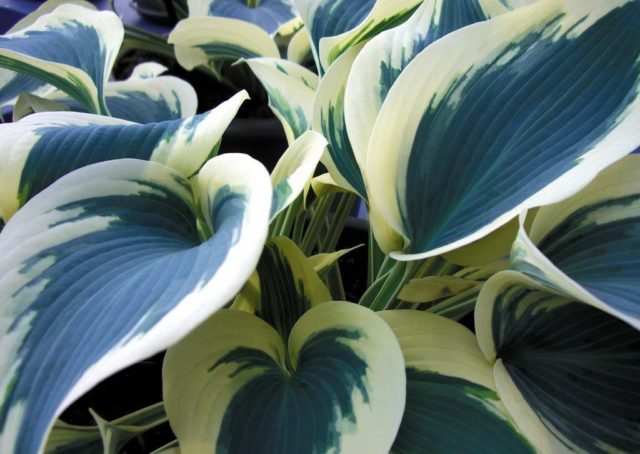
The leaves of the Blue Ivory hosts are wider than those of the Fern Line.
Application in landscape design
Due to its interesting color, lush foliage and unpretentiousness, Blue Ivory is often used to decorate the garden:
- in single landings;
- in combination with other types of host;
- in carpet plantings;
- in flower arrangements - bright flowers contrast well against its background;
- in rock gardens and rockeries.
Blue Ivory goes well with different colors:
- peonies;
- forget-me-nots;
- astilbe;
- undersized daylilies.
It is also appropriate to plant it in compositions with conifers:
- dwarf firs;
- different types of thuja;
- juniper.
Hosta gets along pretty well with different plants. But you should not plant it next to actively growing, spreading bushes, which completely obscure its view.

Hosta Blue Ivory is in perfect harmony with other varieties and bright colors
Breeding methods
Blue Ivory can be propagated:
- seeds;
- cuttings;
- dividing the bush.
It is better to breed relatively mature plants at the age of 4 years and older. The fastest way is to divide the bush. It is carried out practically in any season - in spring, summer and even autumn, and no later than a month before frost.
To divide the bush, proceed as follows:
- Cut the ground with a sharp shovel within a radius of 35 cm from the center of the plant (you can navigate by the size of the hosta bush).
- Dig the bush together with the ground.
- Hit the surface several times to shake off the soil.
- With the help of a sharp knife, cut it into several pieces so that each division has 2-3 sprouts.
- They are transplanted to a new place at about the same depth.
- For the winter they mulch (in the southern regions this is not necessary).
Landing algorithm
It is better to purchase the Blue Ivory host in proven nurseries or specialized stores. When buying, you need to carefully examine the roots: they must be healthy, without visible damage and contain 2-3 or more growth buds.
Usually the hosta is planted in the second half of April, when the snow has completely melted, and the probability of night frosts is close to zero. In the south, this is the beginning of April, in the middle lane - the end of the month, and in the Urals and Siberia - the beginning or even mid-May.
When choosing a place, the main attention is paid to the presence of shade: the Blue Ivory host grows well next to spreading bushes or trees. Also, the place should be protected from open drafts and stagnant moisture (ideally plant on a small hill). The hosta is not demanding on the soil - it grows even on depleted soil, subject to regular fertilization. The reaction can be neutral or slightly acidic; alkaline soil is undesirable.
The planting instructions are as follows:
- The plot is dug up in 2 weeks, complex fertilizer and a bucket of humus per 1 m2 are added. If you do not do this right away, humus can then be added directly into the hole.
- Dig several holes of small depth and diameter - 30 cm.
- Pour a mixture of garden soil with a small amount of peat and a few handfuls of sand. If the soil is infertile, you can add rotted manure.
- Small stones are laid at the bottom of the hole.
- Half of the soil is poured and watered.
- Root the hosta and add the remaining earth.
- Water and mulch again with hay, straw or pine needles.
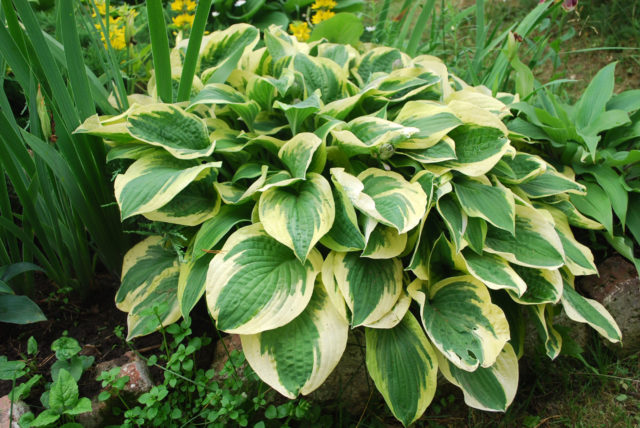
With proper care of the Blue Ivory host, you can get a lush, spreading bush.
Growing rules
Hosta Blue Ivory does not need particularly careful care. To successfully grow this beautiful bush, you must follow a few simple rules:
- Water regularly, especially in dry weather, and keep the soil moderately moist at all times. Excessive moisture is not allowed.
- Already in the spring, it is better to lay a layer of mulch so that the soil retains moisture well. In addition, mulching prevents weeds from growing.
- Periodically loosen the soil, which is especially important for young seedlings.
As for fertilizers, it is optimal to apply them 3 times per season:
- In April, add urea, ammonium nitrate or other nitrogen fertilizer for lush growth of leaves.
- In the middle of summer, potassium salt and superphosphates are added to maintain flowering.
- In the last decade of August, the same composition is added. After that, you do not need to feed.
At the same time, additional feeding should not be added in the first year - the plant has enough humus or manure introduced into the pit during planting.
Preparing for winter
Blue Ivory is very resistant to frost, so there is no need to cover it for the winter. Usually in the fall, several procedures are carried out with the plant:
- All wilted peduncles are removed - they are cut off completely.
- If necessary, remove old foliage and obviously damaged shoots.
- The trunk circle is mulched with hay, straw, peat or needles. It is not necessary to specially cover the bush with burlap or other materials.
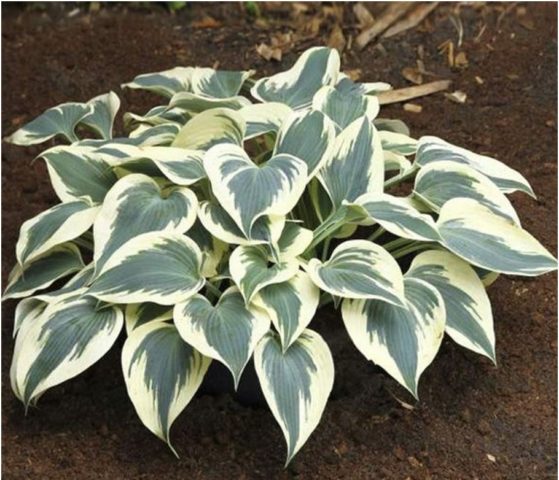
The Blue Ivory host does not need to shelter for the winter
Diseases and pests
Blue Ivory, like many other host species, is resistant to diseases and pests. But sometimes she is struck by such diseases:
- rot of the root collar (leaves turn yellow and become soft);
- the HVX virus is a specific pathogen that parasitizes only on hosts (rings, spots or extraneous streaks appear on the leaves).
At the first symptoms, damaged leaves and shoots should be cut off and burned.If the bush continues to hurt, you will have to part with it so that it cannot infect neighboring hosts.
Also on Blue Ivory snails and slugs love to parasitize. They can be collected manually and then processed:
- saturated saline solution;
- 10% solution of vitriol (iron or copper);
- a dry mixture of ash, red pepper and mustard (ratio 2: 1: 1) - it is scattered on the ground, in the trunk circle.
Typical pests (aphids, spider mites, scale insects and others) rarely settle on the host. But if they are found, it is necessary to immediately carry out an insecticide treatment. For example, you can use Green Soap, Decis, Confidor, Karbofos. If the hosta Blue Ivory is affected by a fungal infection (gray rot, rust and others), fungicides are used (Topaz, Spor, Maxim, Bordeaux liquid).
Conclusion
Hosta Blue Ivory is sure to be a decoration of any garden. It looks especially beautiful in composition with other hosts and flowers - for example, in mixborders or on rocky flower beds, in rock gardens. This non-capricious plant tolerates winter well, so it can be grown in almost any Russian region.
